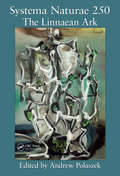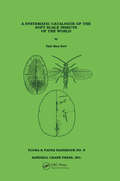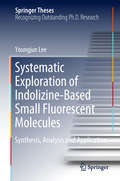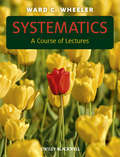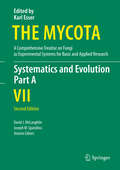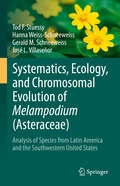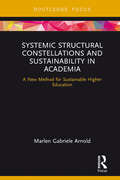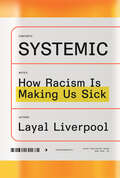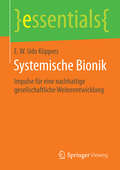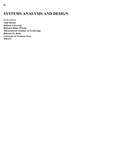- Table View
- List View
Systema Naturae 250 - The Linnaean Ark
by Andrew PolaszekThe advent of relational databasing and data storage capacity, coupled with revolutionary advances in molecular sequencing technology and specimen imaging, have led to a taxonomic renaissance. Systema Naturae 250 - The Linnaean Ark maps the origins of this renaissance, beginning with Linnaeus, through his "apostles", via the great unsung hero Charl
Systematic Approach to Evaluation of Mouse Mutations
by John P. Sundberg Dawnalyn BoggessExperts from The Jackson Laboratory and around the world provide practical advice on everything from how to establish a colony to where to go for specific mutations. The book includes information on medical photography, grafting procedures, and how to map the genes and evaluate the special biological characteristics of mice. It also discusses how to maintain a colony of mice that breed with difficulty, how to approach mapping spontaneous mutations, how to set up systems to evaluate a specific antibody, how to perform simple measurements that yield a large amount of information, and how to access mouse informatics on the Web.
Systematic Botany of Flowering Plants: A New Phytogenetic Approach of the Angiosperms of the Temperate and Tropical Regions
by R E. SpichigerThe principle objective of this book is to describe a range of families of flowering plants in a sequence corresponding to current phylogenetic classification based on the most recent results of molecular systematics. The selection of families is large and comprises families of temperate European flora as well as tropical flora. They are integrated in their respective orders and keys are given to help the reader recognize them. Each family is richly illustrated, the identifying characters being shown as clearly as possible. A glossary complements the overall didactic qualities of this reference.
Systematic Catalogue of the Soft Scale Insects of the World
by Yair Ben-DovA catalogue of the soft-scale insects of the world (Homoptera: Coccoidea: Cocidae) with data on geographical distribution, host plants, biology and economic importance. This catalogue lists 162 genera comprising 1090 species and subspecies which have been described since Linnaeus (1758) until the cutoff date of December 1991. Extensive data are presented on taxonomy, nomenclature, synonyms, geographical distribution, host plants, biology, and economic importance of the species. New combinations are established for 40 species. One species, namely Filippia subterranea Gomez-Menor Ortega, is newly synonymized with Lecanopsis formicarum Newstead.
Systematic Changes in Body Image Following Formation of Phantom Limbs
by Nobuyuki InuiThis book presents new findings on body image and also introduces new neuroscience-based methods for the fields of neurology and neurorehabilitation. Even when the hand is stationary we know its position - information that is needed by the brain to plan movements. If the sensory input from a limb is removed as the result of an accident, or as part of an experiment with local anesthesia, then a 'phantom' limb commonly develops. We used ischemic anesthesia of one limb to study the mechanisms that define this phenomenon. Surprisingly, if the fingers, wrist, elbow, ankle, and knee are extended before and during an ischemic block, then the perceived limb is flexed at the joint and vice versa. Furthermore, the limb is perceived to move continuously with no default position. The key parameter for these illusory changes in limb position is the difference in discharge rates between afferents in the flexor and extensor muscles at a joint. The final position of the phantom limb depends on its initial position, suggesting that a body image uses incoming proprioceptive information for determination of starting points and endpoints when generating movements. In addition, the change in position does not involve limb postures that are anatomically impossible, suggesting that illusory posture is constrained by body maps. These results provide new information about how the brain generates phantom limbs.
Systematic Exploration of Indolizine-Based Small Fluorescent Molecules: Synthesis, Analysis, And Application (Springer Theses)
by Youngjun LeeThis thesis describes an in-depth study of an indolizine-based fluorophore, from understanding of its structure-photophysical property relationship to its application as a useful biological reporter.Organic fluorophores have been extensively used in the field of molecular biology owing to their excellent photophysical property, suitable cell permeability, and synthetic flexibility. Understanding of the structure-photophysical property relationship of a given fluorophore often paves the road to the development of valuable molecular probes to visualize and transcribe biological networks. In this thesis, respective chapters deal with molecular design, organic synthesis, structure-property analysis, and quantum-mechanical interpretation of unexplored family of indolizine-based molecules. This systematic exploration has led to rational development of a new microalgae lipid droplet probe, colorful bioorthogonal fluorogenic probes, and a bright mitochondrial probe, working under live cell conditions.Harnessing the optical properties of a given fluorophore has been an important topic for a couple of decades, both in industry and in academia. This thesis provides useful insights for the improvement and development of unique small fluorescent materials, or optical materials.
Systematics
by Ward C. WheelerSystematics: A Course of Lectures is designed for use in an advanced undergraduate or introductory graduate level course in systematics and is meant to present core systematic concepts and literature. The book covers topics such as the history of systematic thinking and fundamental concepts in the field including species concepts, homology, and hypothesis testing. Analytical methods are covered in detail with chapters devoted to sequence alignment, optimality criteria, and methods such as distance, parsimony, maximum likelihood and Bayesian approaches. Trees and tree searching, consensus and super-tree methods, support measures, and other relevant topics are each covered in their own sections.The work is not a bleeding-edge statement or in-depth review of the entirety of systematics, but covers the basics as broadly as could be handled in a one semester course. Most chapters are designed to be a single 1.5 hour class, with those on parsimony, likelihood, posterior probability, and tree searching two classes (2 x 1.5 hours).
Systematics and Evolution
by David J. Mclaughlin Joseph W. SpataforaThis volume includes treatments of systematics and related topics for both fungi and fungus-like organisms in four eukaryotic supergroups, as well as specialized chapters on nomenclature, techniques and evolution. These organisms are of great interest to mycologists, plant pathologists and others, including those interested in the animal parasitic Microsporidia. Our knowledge of the systematics and evolution of fungi has made great strides since the first edition of this volume, largely driven by molecular phylogenetic analyses. Consensus among mycologists has led to a stable systematic treatment that has since become widely adopted and is incorporated into this second edition, along with a great deal of new information on evolution and ecology. The systematic chapters cover occurrence, distribution, economic importance, morphology and ultrastructure, development of taxonomic theory, classification, and maintenance and culture. Other chapters deal with nomenclatural changes necessitated by revisions of the International Code of Nomenclature for algae, fungi and plants, including the elimination of separate names for asexual states, as well as methods for preservation of cultures and specimens, character evolution and methods for ultrastructural study, the fungal fossil record, and the impact of whole genomes on fungal studies.
Systematics and the Exploration of Life
by Philippe Grandcolas Marie-Christine MaurelThis book's aim is to obtain and organize knowledge about the diversity of living things. Their epistomological and methodological fundamentals are explained in the framework of the biology of evolution. The methods of construction and use of phylogenetic trees are presented as well as the classification and description of taxa with the nomenclature rules.
Systematics as Cyberscience: Computers, Change, and Continuity in Science
by Christine HineAn exploration of the use of information and communication technologies by biologists working in systematics (taxonomy) and the dynamics of change and continuity with past practices in the development of systematics as a cyberscience.
Systematics, Ecology, and Chromosomal Evolution of Melampodium (Asteraceae): Analysis of Species from Latin America and the Southwestern United States
by Tod F. Stuessy Hanna Weiss-Schneeweiss Gerald M. Schneeweiss José L. VillaseñorChromosomal change has been important in the evolution of flowering plants. Cytogenetic modifications resulting in dysploid and polyploid alterations of plant genomes have often led to the formation of new species. A genus that represents an excellent example of such changes during its evolutionary history is Melampodium (Asteraceae), occurring primarily in Mexico, Central America, and the southwestern United States. This book is a detailed presentation of the diversity of species in Melampodium, their ecological requirements and phylogenetic relationships, the biogeographic patterns and migrational pathways, chromosomal diversity, and evolutionary origins of species, especially the tetraploids and hexaploids through allopolyploidy. It is an instructive case study of evolution through chromosomal change in a broadly distributed genus of importance in the ecosystems of Mexico and adjacent regions.
Systematics, Evolution, and Ecology of Melastomataceae
by Renato Goldenberg Fabián A. Michelangeli Frank AlmedaThis book presents a synthesis of critical new information for the Melastomataceae, one of the ten richest families among flowering plants with over 5,800 species that has its diversity highly concentrated in tropical or subtropical areas. It describes the family’s global diversity and distribution and summarizes recent advances in systematics, evolution, biogeography, reproductive biology and ecology.
Systematik der Pflanzen kompakt
by Birgit GemeinholzerDieses Kompakt-Lehrbuch vermittelt ein grundlegendes Verständnis für die Klassifizierung von Pflanzen und gibt Einblicke in den Artenreichtum der Pflanzenwelt. Es richtet sich an Bachelor- und Masterstudierende der verschiedensten Fachrichtungen. Die Autorin beschreibt hierzu die Pflanzensystematik auf dem aktuellsten Stand der Wissenschaft. Nach einer fundierten Einleitung zu den Grundlagen der Systematik, Taxonomie, Nomenklatur und Evolutionsforschung, lernt der Leser die einzelnen Pflanzengruppen und ihre Merkmale kennen. Das im Text vermittelte Fachwissen wird mithilfe von zahlreichen detaillierten Abbildungen veranschaulicht, was zu einem guten Verständnis des Buches und schnellem Lernerfolg beiträgt.
Systemic Circular Economy Solutions for Fiber Reinforced Composites (Digital Innovations in Architecture, Engineering and Construction)
by Marcello Colledani Stefano TurriThis open access book provides an overview of the work undertaken within the FiberEUse project, which developed solutions enhancing the profitability of composite recycling and reuse in value-added products, with a cross-sectorial approach. Glass and carbon fiber reinforced polymers, or composites, are increasingly used as structural materials in many manufacturing sectors like transport, constructions and energy due to their better lightweight and corrosion resistance compared to metals. However, composite recycling is still a challenge since no significant added value in the recycling and reprocessing of composites is demonstrated. FiberEUse developed innovative solutions and business models towards sustainable Circular Economy solutions for post-use composite-made products. Three strategies are presented, namely mechanical recycling of short fibers, thermal recycling of long fibers and modular car parts design for sustainable disassembly and remanufacturing. The validation of the FiberEUse approach within eight industrial demonstrators shows the potentials towards new Circular Economy value-chains for composite materials.
Systemic Delivery Technologies in Anti-Aging Medicine: Methods and Applications (Healthy Ageing and Longevity #13)
by Wing-Fu LaiThis book presents a multidisciplinary assessment of the state of science in the use of systemic delivery technologies to deliver anti-aging therapeutics now under development. There is a gap between basic aging research and the development of intervention technologies. This major obstacle must be overcome before biogerontological interventions can be put into clinical practice. As biogerontology comes to understand aging as a systemic degenerative process, it is clear that there is a pressing need for technologies that enable cells and tissues in a fully developed adult body to be manipulated systemically to combat aging. The authors review advances in the chemistry and engineering of systemic delivery methods and analyze the strengths and limitations of each.The book is organized into six sections. The first offers an overview of the need for systemic delivery technologies alongside the development of anti-aging therapies and describes approaches that will be required for studying the properties and efficiency of carriers for systemic delivery. Sections II, III and IV describe recent advances in a range of strategies that may enable systemic delivery to help combat aging conditions ranging from cell senescence to decline in immune function and hormonal secretion. Section V discusses practical strategies to engineer and optimize the performance of delivery technologies for applications in systemic delivery, along with their working principles. The final section discusses technical and biological barriers that must be overcome as systemic delivery technologies move from research laboratory to clinical applications aimed at tackling aging and age-associated diseases.Benefiting scholars, students and a broader audience of interested readers, the book includes helpful glossary sections in each chapter, as well as sidebars that highlight important notes, and questions for future research.
Systemic Remediation: Approaching Sustainable Development Narratives from the Nigerian Afro-Igbo Mmadụ Perspective (Environmental Humanities: Transformation, Governance, Ethics, Law #4)
by Chijioke Francis NwosuSince the issues and discourses surrounding sustainable development entered its phase in our contemporary world, the political, social, economic, ecological, and cultural existence of our modern world has inevitably adopted varied measures to respond better to the demands of our time. This book contributes to the global call for transitions and transformations towards a more sustainable human society. This contribution is specific, dialogic and comparative and also has deep cultural and ethnological consciousness based on the Nigerian experiences and, by extension, the African experience. The research work presents as its background the hypothesis that varied forms of structures—socio-political, socio-economic, socio-ecological and socio-cultural—unite to constitute ‘structural sins’ (John Paul II) and, consequently, the banes to authentic and sustainable development. These dysfunctional structures were critically analysed and evaluated. Furthermore, the research work takes up the contemporary discourse on sustainable development, beginning with earlier development concepts, the impactful contribution of social documents of the church to development discourse, the timeline of the general global and sustainable development approach and governance, as well as the specifics of the twin documents of the year 2015, namely Agenda 2030 and Laudato Si. Again, an indigenised manuscript for development discourse known as Nigeria Vision 20:2020 was examined to delineate the fact that forms of indigenous efforts to discuss and administrate the development process are noticeable. However, such efforts have remained negatively exploited by both internal and external man-made corrupt factors. One such factors discussed in this book, among others, is the failure of Nigeria since independence to stabilise its power and energy sector.
Systemic Risk and Complex Networks in Modern Financial Systems (New Economic Windows)
by Vincenzo PacelliThis open access book is a groundbreaking exploration of systemic risk in modern financial systems. Through its theoretical and empirical investigations, it reveals the multidimensionality of systemic risk, the transmission channels of crises, and the interlinkages between physical, transition, and financial risks. It introduces cutting-edge methodologies, including prediction and optimization models based on complex networks, multilayer networks and eXplainable Artificial Intelligence (XAI) approaches, to forecast and measure systemic risk and financial crisis. It provides insight for academics, practitioners, policy and supervisory authorities, and bankers and financial market operators on understanding the links that determine the propagation of financial crises and the emergence of systemic risks. This book is essential for those wishing to better understand systemic risk and its implications.
Systemic Sex Therapy
by Gerald R. Weeks Katherine Milew Hertlein Gerald Weeks Nancy Gambescia Katherine M. HertleinSystemic Sex Therapyserves as an introduction to the field of sex therapy from a systems perspective. It is an excellent resource for graduate students in marriage and family therapy programs or students and professionals who want a truly fresh perspective on sex therapy. This approach moves beyond traditional behavioral approaches to incorporate individual, couple, and intergenerational factors in etiology and treatment. Unlike current books on the market that are outdated, too advanced, simplistic, unfocused, or too diffuse in content, Systemic Sex Therapyis comprehensive, concise, highly focused on treatment, user-friendly, and contains features not found in other sex therapy texts, such as a systemic/behavioral focus, clinical innovation, and a greater focus on implementation rather than competing works.
Systemic Structural Constellations and Sustainability in Academia: A New Method for Sustainable Higher Education
by Marlen ArnoldIn order to create truly sustainable universities, we require new methods of visualising and interpreting them holistically as institutions built on complex relationships and systems, rather than as individual departments and people operating independently. This book uses a systemic structural constellations approach to demonstrate how we can build more sustainable higher education institutions, both in terms of teaching and research and at an operational level. Drawing examples from current research and teaching, Systemic Structural Constellations and Sustainability in Academia explores how universities are not only centres of teaching and learning but can also play a crucial role in enabling future decision-makers to appreciate and contribute to a more sustainable future. Providing a clear introduction to systemic structural constellations and guidance on how to practically apply the theory to numerous aspects of the higher education system, this book will be of great interest to students and researchers of education for sustainable development, organisational learning and sustainable management, as well as those tasked with transforming the higher education system for the future.
Systemic Vasculitis
by M. Habib Bouhaouala Anthony W. Stanson Lotfi Hendaoui Francis JoffreThe prompt diagnosis of systemic vasculitis is essential as a missed diagnosis can be disastrous. Imaging is of vital importance in achieving a correct diagnosis and in some cases also plays a role in endovascular treatment. In this book, the imaging features of the many different types of vasculitis are clearly demonstrated by means of numerous high-quality illustrations. All relevant imaging modalities are considered, and key distinctive characteristics are highlighted. In addition, each chapter discusses the etiology, epidemiology, pathogenesis, clinical presentation, biology, and treatment of the vasculitis in question. This book is the result of cooperation between expert teams from a range of countries. The wealth of illustrations and informative clinical case studies will prove invaluable for all who may be confronted with these problematic disorders.
Systemic: How Racism Is Making Us Sick
by Layal LiverpoolIn the spirit of Medical Apartheid and Killing the Black Body; A science-based, data-driven, and global exploration of racial disparities in health care access by virologist, immunologist, and science journalist Layal Liverpool.Layal Liverpool spent years as a teen bouncing from doctor to doctor, each one failing to diagnose her dermatological complaint. Just when she&’d grown used to the idea that she had an extremely rare and untreatable skin condition, one dermatologist, after a quick exam, told her that she had a classic (and common) case of eczema and explained that it often appears differently on darker skin. Her experience stuck with her, making her wonder whether other medical conditions might be going undiagnosed in darker-skinned people and whether racism could, in fact, make people sick.The pandemic taught us that diseases like Covid disproportionately affect people of color. Here, Liverpool goes a step further to show that this disparity exists for all types of illness and that it is caused by racism. In Systemic, Liverpool shares her journey to show how racism, woven into our societies, as well as into the structures of medicine and science, is harmful to our health. Refuting the false belief that there are biological differences between races, Liverpool goes on to show that racism-related stress and trauma can however, lead to biological changes that make people of color more vulnerable to illness, debunking the myth of illness as the great equalizer.From the problem of racial bias in medicine where the default human subject is white, to the dangerous health consequences of systemic racism, from the physical and psychological effects of daily microaggressions to intergenerational trauma and data gaps, Liverpool reveals the fatal stereotypes that keep people of color undiagnosed, untreated, and unsafe, and tells us what we can do about it.
Systemics of Incompleteness and Quasi-Systems (Contemporary Systems Thinking)
by Gianfranco Minati Mario R. Abram Eliano PessaThis book contains the proceedings of the Seventh National Conference of the Italian Systems Society. The title, Systemics of Incompleteness and Quasi-Systems, aims to underline the need for Systemics and Systems Science to deal with the concepts of incompleteness and quasiness. Classical models of Systemics are intended to represent comprehensive aspects of phenomena and processes. They consider the phenomena in their temporal and spatial completeness. In these cases, possible incompleteness in the modelling is assumed to have a provisional or practical nature, which is still under study, and because there is no theoretical reason why the modelling cannot be complete. In principle, this is a matter of non-complex phenomena, to be considered using the concepts of the First Systemics. When dealing with emergence, there are phenomena which must be modelled by systems having multiple models, depending on the aspects being taken into consideration. Here, incompleteness in the modelling is intrinsic, theoretically relating changes in properties, structures, and status of system. Rather than consider the same system parametrically changing over time, we consider sequences of systems coherently. We consider contexts and processes for which modelling is incomplete, being related to only some properties, as well as those for which such modelling is theoretically incomplete—as in the case of processes of emergence and for approaches considered by the Second Systemics. In this regard, we consider here the generic concept of quasi explicating such incompleteness. The concept of quasi is used in various disciplines including quasi-crystals, quasi-particles, quasi-electric fields, and quasi-periodicity. In general, the concept of quasiness for systems concerns their continuous structural changes which are always meta-stable, waiting for events to collapse over other configurations and possible forms of stability; whose equivalence depends on the type of phenomenon under study. Interest in the concept of quasiness is not related to its meaning of rough approximation, but because it indicates an incompleteness which is structurally sufficient to accommodate processes of emergence and sustain coherence or generate new, equivalent or non-equivalent, levels. The conference was devoted to identifying, discussing and understanding possible interrelationships of theoretical disciplinary improvements, recognised as having prospective fundamental roles for a new Quasi-Systemics. The latter should be able to deal with problems related to complexity in more general and realistic ways, when a system is not always a system and not always the same system. In this context, the inter-disciplinarity should consist, for instance, of a constructionist, incomplete, non-ideological, multiple, contradiction-tolerant, Systemics, always in progress, and in its turn, emergent.
Systemische Bionik: Impulse für eine nachhaltige gesellschaftliche Weiterentwicklung (essentials)
by E. W. Udo KüppersDieses Essential vermittelt einen grundlegenden Einblick in die Systemische Bionik als Grenzen überwindende Disziplin. Der Autor erläutert auf leicht verständliche Weise, welchen Wert die Bionik für ganzheitliche Problemlösungen bietet und welche Rolle eine intakte Natur dabei spielt. Wegweisend und zielführend bei diesem systembionischen Vorgehensmodell ist das Erkennen von Zusammenhängen in Natur und Technik.
Systemleichtbau für die Luftfahrt (essentials)
by Martin Wiedemannessentials liefern aktuelles Wissen in konzentrierter Form. Die Essenz dessen, worauf es als „State-of-the-Art“ in der gegenwärtigen Fachdiskussion oder in der Praxis ankommt. essentials informieren schnell, unkompliziert und verständlichals Einführung in ein aktuelles Thema aus Ihrem Fachgebietals Einstieg in ein für Sie noch unbekanntes Themenfeldals Einblick, um zum Thema mitreden zu könnenDie Bücher in elektronischer und gedruckter Form bringen das Fachwissen von Springerautor*innen kompakt zur Darstellung. Sie sind besonders für die Nutzung als eBook auf Tablet-PCs, eBook-Readern und Smartphones geeignet. essentials sind Wissensbausteine aus den Wirtschafts-, Sozial- und Geisteswissenschaften, aus Technik und Naturwissenschaften sowie aus Medizin, Psychologie und Gesundheitsberufen. Von renommierten Autor*innen aller Springer-Verlagsmarken.Dies ist ein Open-Access-Buch.
Systems Analysis And Design
by Alan Dennis Roberta M. Roth Barbara Haley WixomThe 6th Edition of Systems Analysis and Design continues to offer a hands-on approach to SAD while focusing on the core set of skills that all analysts must possess. Building on their experience as professional systems analysts and award-winning teachers, authors Dennis, Wixom, and Roth capture the experience of developing and analyzing systems in a way that students can understand and apply. With Systems Analysis and Design, 6th Edition, students will leave the course with experience that is a rich foundation for further work as a systems analyst.
